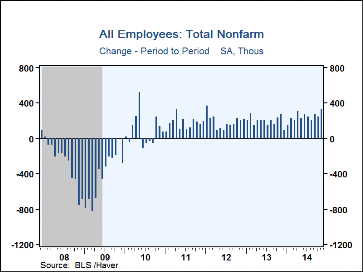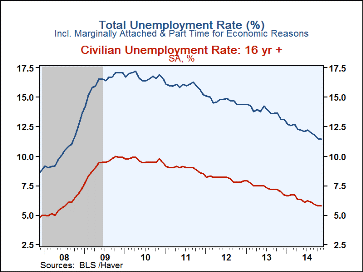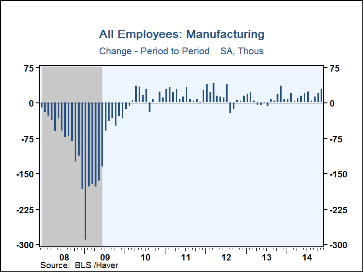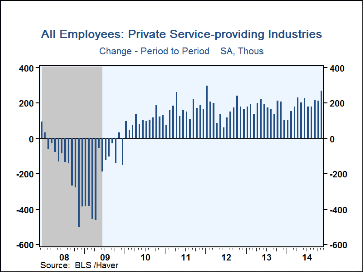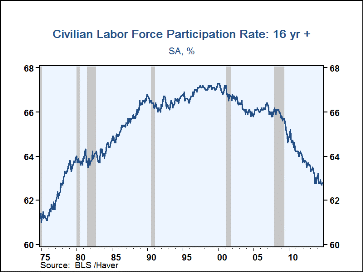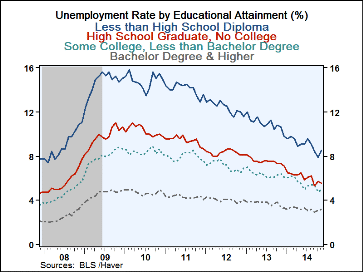 Global| Dec 05 2014
Global| Dec 05 2014U.S. Payrolls Jump; Unemployment Rate Remains At 2008 Low
by:Tom Moeller
|in:Economy in Brief
Summary
Nonfarm payrolls surged 321,000 during November (2.0% y/y) following upwardly revised increases of 243,000 and 271,000 during the prior two months. The gain outpaced expectations for a 225,000 rise in the Action Economics Forecast [...]
Nonfarm payrolls surged 321,000 during November (2.0% y/y) following upwardly revised increases of 243,000 and 271,000 during the prior two months. The gain outpaced expectations for a 225,000 rise in the Action Economics Forecast Survey. The unemployment rate held at 5.8%, its lowest level since July 2008. Expectations had been for 5.9%. The overall jobless rate, including workers who were marginally attached and those employed part-time for economic reasons, slipped to 11.4%.
From the payroll jobs survey, the 321,000 increase in employment (2.0% y/y) was the largest gain since January 2012. Job growth improved across industry categories. Factory sector employment rose 28,000 (1.4% y/y), its strongest rise in twelve months and driven by the nondurable goods sector. Construction sector jobs increased 20,000 (3.6% y/y), the best gain in three months. Private service-producing industries produced an outsized 266,000 improvement (2.3% y/y), the quickest hiring pace since January 2012. Professional & business services jobs jumped 86,000 (3.7% y/y), helped by a firm 22,700 rise (8.5% y/y) in temporary help. Trade, transportation & utilities employment gained 71,000 (2.1% y/y) and retail service sector jobs advanced 50,200 (1.9% y/y), boosted by a 6,400 rise (9.1% y/y) in nonstore jobs. Hiring in health care & social services gained 37,200 (2.0% y/y) and leisure & hospitality employment increased 32,000 (2.6% y/y). Jobs in transportation & warehousing rose 16,7000 (3.1% y/y) and financial industries employment grew an improved 20,000 (1.4% y/y). Information sector hiring gained 4,000 (0.1% y/y). In the government sector, payrolls grew a steady 7,000 (0.4% y/y). Federal government employment rose 5,000 (-0.7% y/y), state government jobs gained 3,000 (0.4% y/y) but local government hiring slipped 1,000 (0.5% y/y).
Hiring was broadly based last month as indicated by a one-month diffusion index of 69.7%, its highest since January 1998. Over three months, 70.6% of industries added jobs. In the factory sector, 63.0% of industries raised employment but over three months, 69.1% added jobs, the most since December.
Average weekly hours-worked rose to 34.6, the highest level since May 2008. The factory sector workweek extended to 41.1 hours, the longest of the recovery, but the construction sector workweek dipped to 39.1 hours. The private service sector workweek held steady at 33.4 hours. Aggregate hours worked (employment times hours) rose 0.6% (2.6% y/y). For Q4, aggregate hours rose 2.8% (AR) from Q3 following a 2.4% rise during that quarter. During the last ten years there has been a 68% correlation between the q/q rise in aggregate hours and the change in real GDP.
Average hourly earnings gained 0.4% (2.1% y/y), the strongest rise since June 2013. The gain was driven by a 0.4% improvement (2.1% y/y) in service sector earnings. Construction sector earnings gained 0.2% (2.7% y/y) and factory sector earnings gained 0.1% (1.5% y/y).
The household employment survey indicated that the unemployment rate held at 5.8%. Employment increased 4,000 (2.0% y/y) while unemployment rose 115,000 (-16.0% y/y). The labor force rose 119,000 (0.7% y/y). The population rose 0.9% y/y, leaving the labor force participation rate of 62.8% stable m/m and near its lowest level since 1977.
For individuals with less than a high school diploma, the unemployment rate was 8.4% and for high school graduates but no college, it was 5.6%. For those with some college, the jobless rate was 4.9% while for college graduates the unemployment rate was 3.2%.
The figures referenced above are available in Haver's USECON database. Additional detail can be found in the LABOR and in the EMPL databases. The expectation figures are from Action Economics and are in the AS1REPNA database.
(Nov.'13)
(Nov.'13)
Tom Moeller
AuthorMore in Author Profile »Prior to joining Haver Analytics in 2000, Mr. Moeller worked as the Economist at Chancellor Capital Management from 1985 to 1999. There, he developed comprehensive economic forecasts and interpreted economic data for equity and fixed income portfolio managers. Also at Chancellor, Mr. Moeller worked as an equity analyst and was responsible for researching and rating companies in the economically sensitive automobile and housing industries for investment in Chancellor’s equity portfolio. Prior to joining Chancellor, Mr. Moeller was an Economist at Citibank from 1979 to 1984. He also analyzed pricing behavior in the metals industry for the Council on Wage and Price Stability in Washington, D.C. In 1999, Mr. Moeller received the award for most accurate forecast from the Forecasters' Club of New York. From 1990 to 1992 he was President of the New York Association for Business Economists. Mr. Moeller earned an M.B.A. in Finance from Fordham University, where he graduated in 1987. He holds a Bachelor of Arts in Economics from George Washington University.


